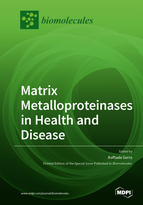Matrix Metalloproteinases in Health and Disease
A special issue of Biomolecules (ISSN 2218-273X). This special issue belongs to the section "Molecular Medicine".
Deadline for manuscript submissions: closed (29 February 2020) | Viewed by 35673
Special Issue Editor
Interests: cardiovascular disease; vascular surgery; biomarkers
Special Issues, Collections and Topics in MDPI journals
Special Issue Information
Dear Colleagues,
Matrix metalloproteinases (MMPs) are members of an enzyme family and are critical for maintaining tissue allostasis. MMPs can catalyze normal turnover of the extracellular matrix (ECM) together with other metalloproteinases such as ADAM (a disintegrin and metalloproteinase) and ADAMTS (a disintegrin and metalloproteinase with thrombospondin motif) families. MMP activity is also regulated by a group of endogenous proteins called tissue inhibitor of metalloproteinases (TIMPs). All these proteins have a pivotal role involving ECM remodelling in normal physiological processes such as wound healing, embryogenesis, angiogenesis, bone remodelling, immunity, and the female reproductive cycle. An imbalance in the expression or activity of MMPs can also have important consequences in diseases such as cancer, cardiovascular disease, peripheral vascular disease, chronic leg ulcers, multiple sclerosis, and others.
In recent years, MMPs have been found to have an important role in the field of precision medicine as they may serve as biomarkers that may predict an individual’s disease predisposition, state, or progression. MMPs are also thought to be a sensible target for molecular therapy.
The aim of this Special Issue is to explore the most recent findings in this field that may have an impact in healthcare systems.
Prof. Raffaele Serra
Guest Editor
Manuscript Submission Information
Manuscripts should be submitted online at www.mdpi.com by registering and logging in to this website. Once you are registered, click here to go to the submission form. Manuscripts can be submitted until the deadline. All submissions that pass pre-check are peer-reviewed. Accepted papers will be published continuously in the journal (as soon as accepted) and will be listed together on the special issue website. Research articles, review articles as well as short communications are invited. For planned papers, a title and short abstract (about 100 words) can be sent to the Editorial Office for announcement on this website.
Submitted manuscripts should not have been published previously, nor be under consideration for publication elsewhere (except conference proceedings papers). All manuscripts are thoroughly refereed through a single-blind peer-review process. A guide for authors and other relevant information for submission of manuscripts is available on the Instructions for Authors page. Biomolecules is an international peer-reviewed open access monthly journal published by MDPI.
Please visit the Instructions for Authors page before submitting a manuscript. The Article Processing Charge (APC) for publication in this open access journal is 2700 CHF (Swiss Francs). Submitted papers should be well formatted and use good English. Authors may use MDPI's English editing service prior to publication or during author revisions.
Keywords
- MMPs
- ADAMs
- ADAMTs
- TIMPs
- cardiovascular disease
- peripheral vascular disease
- wound healing
- chronic leg ulcers
- cancer
- multiple sclerosis







